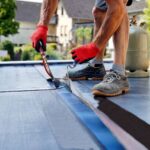 Flat Roofing Services
Flat Roofing Services
Flat roofs are a popular choice for residential, commercial, and industrial structures because they are convenient, cost-effective, and adaptable. Unlike pitched roofs, which have a severe slope, flat roofs have a moderate incline or are fully flat, providing distinct architectural opportunities and functional benefits.
Materials for Flat Roofs:
Several materials are typically used for services like Flat Roofing in Weybridge, each with unique benefits in terms of durability, cost, and aesthetics. Some of the most popular flat roofing materials are:
Built-up Roofing (BUR):
Built-up roofing, commonly known as tar and gravel roofing, is made up of several layers of asphalt-impregnated felt or fiberglass reinforcing matting interspersed with layers of hot-applied bitumen. Gravel or mineral granules are put in the top layer to provide UV and weather resistance. BUR systems offer superior waterproofing and durability, making them ideal for low-slope and flat roofs.
Modified bitumen roofing:
It is a modern alternative to traditional BUR systems, made up of asphalt-based membranes reinforced with polyester or fiberglass mats. These membranes are often put in numerous layers with heat welding or cold adhesives, which improves flexibility, durability, and resilience to temperature variations.
Single-ply Membrane Roofing:
Single-ply membrane roofing systems are composed of synthetic materials such as ethylene propylene diene terpolymer (EPDM), thermoplastic polyolefin (TPO), and polyvinyl chloride (PVC).
These membranes are manufactured in big rolls and put in a single layer, allowing for quick and easy installation. Single-ply membranes are lightweight, flexible, and resistant to UV rays, chemicals, and punctures, making them perfect for flat roofs.
EPDM roofing membranes:
They are a common choice for flat roofs due to their great durability and weather resistance. EPDM membranes are manufactured in huge sheets and attached using adhesives or mechanical fasteners. EPDM roofs are noted for their durability, with a normal lifespan of 30 years or longer.
TPO Roofing:
Thermoplastic polyolefin (TPO) roofing membranes are an affordable and environmentally beneficial solution for flat roofs. TPO membranes are heat-welded together to create a seamless watertight barrier that reflects sunlight and lowers energy expenses. TPO roofs are lightweight, strong, and resistant to mold, algae, and punctures.
PVC roofing:
Such membranes are similar to TPO membranes, however they are built of a different thermoplastic substance. PVC roofs have high weather resistance, chemical resistance, and fire retardancy, making them ideal for a variety of flat roofing applications.
Installation of Flat Roof
Flat Roofing installation requires several important processes to ensure optimum waterproofing, insulation, and structural integrity. Here’s an outline of the standard installation procedure for flat roofing:
Preparation:
It involves inspecting the current roof surface for damage, debris, and wetness. Any necessary repairs or alterations are undertaken to provide a smooth and solid substrate for the new roofing system.
Insulation:
Insulation boards are placed on the roof deck to offer thermal insulation and improve energy efficiency. Proper insulation helps manage indoor temperatures and lowers heating and cooling costs.
Membrane Installation:
The selected roofing membrane, whether BUR, modified bitumen, single-ply, EPDM, TPO, or PVC, is installed in accordance with the manufacturer’s instructions. Membranes can be glued, mechanically secured, or heat-welded to the roof deck, depending on the installation method.
Flashing and edging:
Flashing strips and edge details are put around roof penetrations, parapet walls, and perimeter margins to form watertight seals and prevent moisture intrusion. Metal, rubber, and specific membrane accessories are all possible flashing materials.
Waterproofing:
Additional waterproofing layers, such as asphalt coatings, liquid membranes, or sealants, can be used to improve the roofing system’s durability and weather resistance.
Finishing Touches:
After the membrane installation is completed, final touches like gravel ballast (for BUR systems), reflective coatings (for energy efficiency), and drainage systems (such as gutters and downspouts) are applied to improve the flat roof’s performance and beauty.
Maintenance of Flat Roofs
Inspection:
Routinely inspect the Flat Roofing in Chiswick surface for signs of damage, such as cracks, blisters, tears, or punctures. Inspect the flashing, seams, and penetrations for signs of wear or degradation.
Debris Removal:
Remove leaves, branches, and dirt from the roof’s surface and drainage systems to prevent water collecting and clogging. Trim any overhanging tree branches to reduce the chance of damage to the roof.
Sealing and Repairs:
To avoid water penetration and structural damage, repair any damaged areas or leaks immediately. Use appropriate sealants, adhesives, or patching materials to seal gaps and seams
